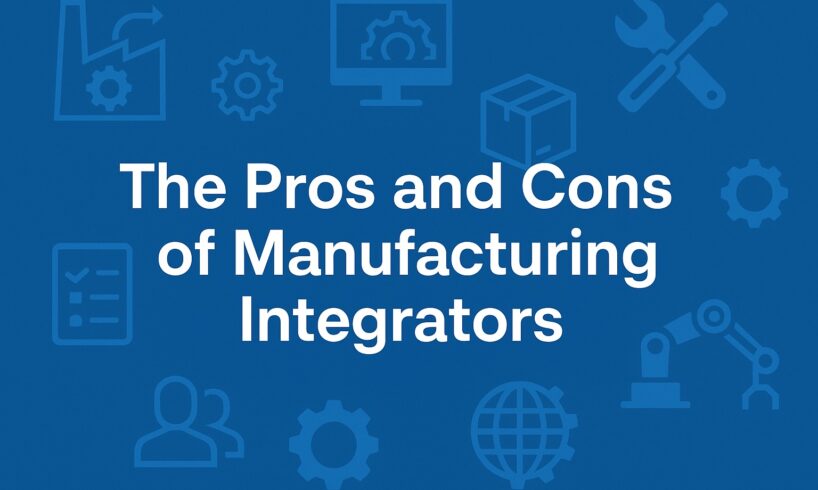
Why Companies Are Turning to Manufacturing Integrators
Companies that build sophisticated products tend to face the same pattern of problems.
Overseas factories offer attractive pricing, but their incentives rarely match yours. Their priority is volume and machine utilization. Your priorities are reliability, risk management, and protecting the intellectual property that makes your product worth anything in the first place.
Strong contracts and registrations help, yet they do not change the basic reality that enforcing your rights overseas is often slow, uncertain, and expensive.
High end manufacturing integrators exist as a response to this gap. Instead of managing a rotating cast of foreign factories, you work with a single domestic partner that sits between you and the actual production network. That partner becomes the entity you can pressure, sue, negotiate with, and hold responsible. They still build or source overseas, but they insulate you from many of the worst outcomes that come from dealing directly with foreign factories.
They do this at a big cost premium.
For high value, high risk, or heavily regulated products, that premium can be a rational investment. For highly commoditized, price sensitive products, it can destroy the economics entirely. Whether an integrator makes sense comes down to your margins, your competitive landscape, and your tolerance for manufacturing risk.
What High End Manufacturing Integrators Actually Do
A manufacturing integrator is not a factory. It is a management and coordination layer between you and the plants that actually make your product. In practical terms, it is a specialized operating company that runs vendor selection, engineering communication, quality control, and logistics for you, while sitting in your home jurisdiction.
A serious integrator will usually:
Qualify and manage foreign factories
Own the day to day engineering feedback loops
Set and enforce quality control processes and inspection plans
Coordinate specialist subcontractors when special processes are required
Control the vendor network while presenting you with a single domestic counterparty
Their business model can vary. Some work on a clear cost plus basis. Others bury their margin in opaque per unit pricing. Either way, they are adding management, systems, and liability on top of the underlying factory network and charging you for it.
The promise is tighter oversight, more predictable quality, and better practical protection for your intellectual property, combined with the leverage of a domestic entity. The catch is cost, loss of direct visibility, and a new layer of dependence.
The Major Advantages of High End Manufacturing Integrators
You Gain a Domestic Counterparty With Real Liability
This is the core structural advantage and the one most companies underestimate.
When you work directly with a foreign factory and something goes wrong, whether it is a quality failure, a tooling dispute, or an IP leak, you are suddenly facing foreign litigation, unfamiliar procedures, translation delays, and a long road to possible recovery. Even if you win, you may never collect, and you may not get relief in time to save a product launch or a key customer relationship.
With a credible integrator, your counterparty is domestic. If your intellectual property leaks through their network, if they mishandle your tooling, if they deliver defective production, they are the one on the hook. You can sue them locally. You can compel performance. They typically have assets, insurance, and reputational exposure where you operate.
This does not magically fix a broken production line in Wuxi, and it does not guarantee full recovery of your losses. What it does is give you real leverage over someone who has the contracts and practical control over the vendor network that hurt you. For companies where a major manufacturing failure would be catastrophic, that shift alone can justify the model.
You Get Stronger Practical IP Protection
Most IP theft is not a dramatic, cinematic event. It is mundane.
An engineer takes drawings to a competitor. A subcontractor reuses a design. A manager shares your CAD files to pitch another customer. When you are dealing directly with foreign factories, you may have contractual protections, but your practical control over what happens inside the plant is limited.
A good integrator treats this as an existential risk to their own business. They build systems to prevent leaks, tighten access to sensitive files, and enforce contractual obligations with vendors. Their agreements with factories, their oversight processes, and their internal controls are all designed to keep your design from escaping.
The incentive alignment is simple. They know that if something goes wrong, you are coming after them, not some anonymous subcontractor in another country. That pressure is worth real money. It does not eliminate IP risk, but it shifts it onto a party with something meaningful to lose in your jurisdiction.
You Reduce Operational Misfires and Supply Chain Chaos
Anyone who has worked directly with typical factories in China or similar locations has seen the same problems:
Tolerances drift. Drawings are misread. Process changes happen without approval. Communication gaps widen because of time zones, language, and inconsistent documentation. Quality problems are often caught late, sometimes after units have shipped.
A competent integrator builds systems specifically to prevent and catch these issues. They define structured workflows, maintain controlled documentation, implement real quality gates, and enforce change control. When that system actually operates as designed, it reduces rework, lost shipments, surprise defects, and last minute engineering fire drills.
Those savings are not theoretical. They show up as fewer recalls, fewer emergency air shipments, fewer scrap batches, and fewer blown launches.
You Offload Vendor and Subcontractor Management
Foreign factories subcontract all the time, often quietly. You may think one factory is building your product when, in reality, multiple plants and shops are touching it.
Nearly all of our firm’s manufacturing agreements explicitly prohibit subcontracting without our client’s written permission. Yet we rarely see manufacturing agreements crafted by others that include that protection. See China Manufacturing and the Bike Lock Theory on Preventing Bad Products.
Top tier integrators are expected to make their vendor networks explicit and take responsibility for them. They should be able to show who is doing what, how long they have worked with those vendors, and how they monitor and audit them. In the best case, you are no longer trying to manage factories in another country. You are managing one domestic partner whose business model is vendor control.
The Real Drawbacks and Hidden Costs
Integrators are not magic. They trade one set of risks for another. Once you understand the advantages, you need to be equally clear on the inherent downsides.
Your Unit Costs Increase Significantly
The integrator’s premium is baked into every unit. It is not a rounding error.
If you compete in a price sensitive market or operate on thin margins, the math may never work. Companies often try to rationalize the added cost by projecting fewer mistakes, smoother production, and fewer crises. The spreadsheet usually tells a less forgiving story.
If your product cannot support the additional dollars per unit an integrator charges, the model is not viable, no matter how attractive it looks operationally.
You Lose Direct Visibility Into the Factory Floor
Integrators often limit direct communication between clients and overseas factories. They want to control information flow and protect their supplier relationships. From their standpoint, that is efficient and defensible. From yours, it creates a layer of opacity.
When production runs smoothly, this structure feels efficient. When problems emerge, it can feel like you are two steps removed from your own supply chain. We have seen situations where the presence of a middle entity, combined with the integrator’s reluctance to expose what is actually happening at the factory level, delayed real resolution by six to twelve months.
You are trading day to day operational involvement for reliance on the integrator’s reporting and honesty. That trade can work, but you should be clear that you are making it.
You Are Bound to Their Standard Contract
Integrators almost always prefer their own contract. On the surface, these agreements sound reassuring. They talk at length about IP protection, quality, and accountability. Behind the language, they are usually written by capable lawyers to protect the integrator, not you.
We often see:
Broad promises paired with narrow remedies
Liability caps that do not cover the real downside
Tooling clauses that give the integrator more control than the client realizes
Vague subcontractor provisions that leave too much room for quiet outsourcing
Some integrators will barely negotiate at all. Others will drag simple changes through long internal legal reviews, hoping you sign the original language out of schedule pressure.
A serious legal review of an integrator’s standard agreement is not optional. It is one of the main value points of hiring counsel before you sign, not after you have a disaster.
Your Supply Chain Risk Is Tied to Their Vendor Network
When you manage factories directly, you own the relationships, for better or worse. When you work through an integrator, you inherit theirs.
If the integrator loses a key supplier, decides to restructure its network, or runs into financial trouble, those shocks hit your product directly. Your supply chain becomes a function of their stability and their conflicts, including disputes that have nothing to do with you.
Our international manufacturing lawyers have seen this play out when a supplier refused to release product because of an unrelated dispute between the supplier and the integrator over a completely different customer. The buyer had no direct contractual relationship with the factory, only with the integrator. Their product was trapped in the middle of someone else’s fight.
This is the core trade. You reduce daily operational friction and front line complexity, and you accept reduced strategic control and a new layer of counterparty risk.
When the Integrator Premium Makes Sense: A Numerical Example
Consider a medical device that costs twenty two dollars to produce at a reputable Asian OEM. An integrator quotes thirty five dollars for the same unit. The difference buys oversight, quality systems, and a domestic counterparty with real liability.
If the device sells for six hundred fifty dollars and carries regulatory and reputational risk, that extra thirteen dollars can make sense. You are protecting a high margin product where a major failure could trigger recalls, regulatory scrutiny, or lasting brand damage. In that context, having a domestic entity positioned to absorb mistakes is often rational.
Now look at a consumer gadget with thin margins. The retail price might only be forty or fifty dollars. Adding thirteen dollars in integrator premium may wipe out your margin entirely. You can tell yourself that better quality will reduce returns and field failures, but you are fighting basic arithmetic.
A useful way to think about it is this:
If a serious quality or IP failure would be survivable and your margins are fragile, an integrator is usually the wrong tool. If a serious failure would be existential and your margins are strong, paying for a layer of domestic liability and systemic control can be rational.
Integrators are not inherently good or bad. They either fit the economics and risk profile of a specific product, or they do not.
How Integrator Models Fail in the Real World
If you are going to use an integrator, you should go in with clear eyes about how the model can break. Common patterns include:
First, integrator insolvency. Your entire supply chain can be disrupted overnight if the integrator runs out of cash or loses a major customer and restructures suddenly.
Second, quiet vendor changes. After the initial phases, some integrators begin switching factories for cost reasons or due to internal disputes, without properly revalidating quality or telling you what changed.
Third, quality system decay. Processes that look impressive during early audits can degrade once the relationship is in a steady state and your team stops watching closely.
Fourth, misrepresented ownership. Many companies have told us that they will be working with “our integrator’s factory.” In reality, it is almost never “their” factory in the legal sense. At best, the integrator owns a holding company that has an interest in a factory. Much more often, “our factory” is just a preferred supplier relationship dressed up for marketing.
Our firm has secured multiple large settlements against integrators that misrepresented their ownership of overseas factories. In those cases, the misrepresentation led to disastrous outcomes for the buyers, and the contracts provided them almost no specific recourse. We had to rely on straightforward misrepresentation claims rather than clean contractual protections.
Fifth, integrator factory disputes. A conflict between the integrator and the factory over a different customer’s project can result in your product being held hostage or deprioritized, even though you did nothing wrong.
None of these risks mean you should never use an integrator. They do mean you should assume the model can fail and structure your contracts and monitoring accordingly.
How to Vet a Manufacturing Integrator Before Signing Anything
Step One: Evaluate Their Financial Strength and Legal Exposure
If an integrator is going to safeguard your IP and manage your production, they need the financial and operational strength to stand behind those obligations.
You should understand their history, ownership, client profile, litigation exposure, and insurance. You should also be realistic about what a judgment against them would be worth in a severe failure scenario. A contract with a thinly capitalized integrator does not provide the protection many companies think it does.
Step Two: Demand Transparency on Their Vendor Network
Ask who their factories are, how long they have worked with them, how often they audit them, and whether those factories also make products for your competitors. A credible integrator will not be vague here.
There is one clear rule. If an integrator will not tell you which factory is actually making your product, walk away. If they disclose the factory but refuse to assume contractual responsibility for that factory and all subcontractors, do the same.
I have had at least two dozen companies tell me that they will be working with “our integrator’s Chinese factory.” In practice, an American company cannot directly own a Chinese factory in the way most people imagine. At best, it owns a Chinese company that owns an interest in a Chinese factory. In most cases, the “owned factory” turns out to be a marketing phrase for a regular supplier relationship.
Step Three: Review Their Standard Agreement Carefully
The integrator’s agreement should make explicit that they are responsible for any IP misuse or theft by anyone they bring into the process, including subcontractors, partner factories, and individual technicians. It should also:
Give you clear ownership or control over tooling
Set liability caps that are meaningful relative to your risk
Define defect liability in concrete terms, not slogans
Limit subcontracting and require your consent for changes
Specify dispute resolution in a way that gives you real leverage
Many integrator contracts weaken their own promises with carve outs, narrow definitions, or limits on remedies that effectively gut the protection. A detailed legal review before you sign is not a formality, it is where a large part of the real negotiation happens.
Step Four: Confirm Their Quality System Is Real
A quality system is a process, not a marketing slide.
You should understand how they inspect, test, document, and validate each stage of production. How do they qualify a new factory? How do they handle engineering changes? How do they respond when a defect is found in the field?
The more vague or defensive their answers, the more concerned you should be. If all you hear are slogans and certifications with no concrete workflows or records, assume the system will fail when you need it most.
Frequently Asked Questions
Do manufacturing integrators actually prevent intellectual property theft?
They reduce the risk, they do not eliminate it.
The real value is that the integrator is a domestic counterparty with assets, insurance, and liability exposure. That pressure gives you more practical leverage and incentivizes them to control their vendor network more tightly than a typical foreign factory would.
Are integrators better than sourcing agents?
Generally, yes. Sourcing agents are often lightly capitalized middle entities with limited oversight capability and very little real liability when things go wrong. Integrators usually have more structured systems, more capital at risk, and more meaningful legal exposure. See Sourcing Agents When Manufacturing Overseas: The Long Version.
That does not mean every integrator is competent or honest. The model is stronger on paper, but it still depends on who you are dealing with and what their contract actually says.
Can an integrator hide which factory is actually making my product?
Some try, and you should never accept that.
If an integrator refuses to disclose their factories, it is a serious warning sign. If they disclose but will not assume contractual liability for all of those vendors, it is a reason to end the conversation.
What should immediately disqualify an integrator during vetting?
A combination of factors, such as those set forth below, should give you pause:
Refusal to disclose where your product will actually be made.
Unwillingness to accept clear contractual responsibility for all subcontractors and overseas partners involved in your product.
Vague or purely marketing level descriptions of their quality system instead of specific processes and records.
Liability caps that are trivial relative to your potential downside.
A litigation history that suggests repeated quality failures, client disputes, or financial instability.
Any one of these deserves serious scrutiny. Two or more usually mean you should move on.
Do integrators specialize by industry or product type?
Most serious integrators specialize, whether they say so explicitly or not.
Some cluster around regulated, high complexity products such as medical devices, aerospace components, or industrial systems. Others focus on consumer electronics, IoT hardware, automotive components, or commercial equipment. Their vendor networks, quality processes, and engineering capabilities tend to follow those patterns.
When you evaluate an integrator, ask where they do most of their work, which standards they operate under, and which categories they avoid. You want an integrator that already lives in your industry, not one learning it for the first time on your project.
Are integrators useful for moving manufacturing out of China or diversifying geography?
Often yes, but not in the way many companies expect.
Integrators can be useful if your team does not have the time or experience to qualify factories in Vietnam, Mexico, India, Eastern Europe, or other locations. A strong integrator will already have a vetted vendor network in multiple countries and can manage the practical work of shifting or duplicating production while giving you a single domestic counterpart.
You should not assume this will be cheap or fast. You pay the integrator’s premium on top of the normal cost and disruption of qualifying new factories, and in many cases parts of their supply chain will remain China centric longer than you would like.
Integrators tend to make the most sense for a China plus one strategy when you move higher margin, strategically important products and want a domestic partner to absorb some of the risk of new geographies. For low margin, highly price sensitive products, it is usually more viable to build and control your own non China supply base directly.
Are integrators a good fit for startups?
Sometimes.
If a startup has a high value, high risk product with strong margins, an integrator can help avoid early manufacturing disasters that could kill the company. If the startup is in a crowded consumer market with fragile unit economics, the integrator’s premium often breaks the model before it ever scales.
The earlier your company is, the more brutally honest you need to be about whether you can afford the extra dollars per unit.
Will the integrator’s contract really protect me?
Possibly, but the cover page and the sales pitch are not where you find out.
Many integrator contracts weaken their own promises through carve outs, limitations, and narrow remedies. The only way to know what protection you are really getting is to read the language closely and negotiate the parts that matter, before you wire the first payment or hand over your IP.
Final Thoughts
High end manufacturing integrators are not turnkey solutions and they are not universally better than managing factories yourself. They are a strategic tool.
They can be powerful allies when the economics and risk profile of your product justify paying for domestic liability, vendor control, and better systems. They can also quietly undermine your business when the premium does not pencil out, when their contracts are one sided, or when their vendor network and quality systems are not what they claim.
The question is not whether integrators are good or bad in the abstract. The question is whether, for your specific product and situation, the premium buys you real liability, control, quality, and predictability, or simply adds another layer of cost and dependence.
If you are evaluating a specific integrator and need a contract review or a risk assessment, we can help you test their claims, stress their proposed terms, and determine whether the relationship strengthens your position or quietly puts it at risk.





